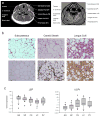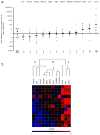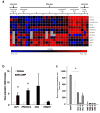Anatomical localization, gene expression profiling and functional characterization of adult human neck brown fat
- PMID: 23603815
- PMCID: PMC3650129
- DOI: 10.1038/nm.3112
Anatomical localization, gene expression profiling and functional characterization of adult human neck brown fat
Abstract
The imbalance between energy intake and expenditure is the underlying cause of the current obesity and diabetes pandemics. Central to these pathologies is the fat depot: white adipose tissue (WAT) stores excess calories, and brown adipose tissue (BAT) consumes fuel for thermogenesis using tissue-specific uncoupling protein 1 (UCP1). BAT was once thought to have a functional role in rodents and human infants only, but it has been recently shown that in response to mild cold exposure, adult human BAT consumes more glucose per gram than any other tissue. In addition to this nonshivering thermogenesis, human BAT may also combat weight gain by becoming more active in the setting of increased whole-body energy intake. This phenomenon of BAT-mediated diet-induced thermogenesis has been observed in rodents and suggests that activation of human BAT could be used as a safe treatment for obesity and metabolic dysregulation. In this study, we isolated anatomically defined neck fat from adult human volunteers and compared its gene expression, differentiation capacity and basal oxygen consumption to different mouse adipose depots. Although the properties of human neck fat vary substantially between individuals, some human samples share many similarities with classical, also called constitutive, rodent BAT.
Figures



Comment in
-
How brown is brown fat? It depends where you look.Nat Med. 2013 May;19(5):540-1. doi: 10.1038/nm.3187. Nat Med. 2013. PMID: 23652104 No abstract available.
References
Reference List
-
- Cannon B, Nedergaard J. Brown adipose tissue: function and physiological significance. Physiol Rev. 2004;84:277–359. - PubMed
-
- Richard D, Picard F. Brown fat biology and thermogenesis. Front Biosci. 2011;16:1233–1260. - PubMed
-
- Orava J, et al. Different metabolic responses of human brown adipose tissue to activation by cold and insulin. Cell Metab. 2011;14:272–279. - PubMed
-
- Wijers SL, Saris WH, Marken Lichtenbelt WD. Individual thermogenic responses to mild cold and overfeeding are closely related. J Clin Endocrinol Metab. 2007;92:4299–4305. - PubMed
-
- van Marken Lichtenbelt WD, et al. Cold-activated brown adipose tissue in healthy men. N Engl J Med. 2009;360:1500–1508. - PubMed
For the Online Methods
-
- Reich M, et al. GenePattern 2.0. Nat Genet. 2006;38:500–501. - PubMed
-
- Tchkonia T, et al. Fat depot-specific characteristics are retained in strains derived from single human preadipocytes. Diabetes. 2006;55:2571–2578. - PubMed
-
- Steenhuis R, Pettway GJ, Ignelzi MA. Cell surface expression of stem cell antigen-1 (Sca-1) distinguishes osteo-, chondro-, and adipoprogenitors in fetal mouse calvaria. Calcif Tissue Int. 2008;82:44–56. - PubMed
Publication types
MeSH terms
Substances
Grants and funding
- DK081604/DK/NIDDK NIH HHS/United States
- DK046200/DK/NIDDK NIH HHS/United States
- DK087317/DK/NIDDK NIH HHS/United States
- UL1RR025758/RR/NCRR NIH HHS/United States
- RC1 DK087317/DK/NIDDK NIH HHS/United States
- R01 DK077097/DK/NIDDK NIH HHS/United States
- K23 DK081604/DK/NIDDK NIH HHS/United States
- UL1 RR025758/RR/NCRR NIH HHS/United States
- UL1 RR 025758/RR/NCRR NIH HHS/United States
- R01 DK082659/DK/NIDDK NIH HHS/United States
- KL2 RR025757/RR/NCRR NIH HHS/United States
- DK077097/DK/NIDDK NIH HHS/United States
- P30 DK046200/DK/NIDDK NIH HHS/United States
- P30 DK036836/DK/NIDDK NIH HHS/United States
LinkOut - more resources
Full Text Sources
Other Literature Sources
Research Materials

